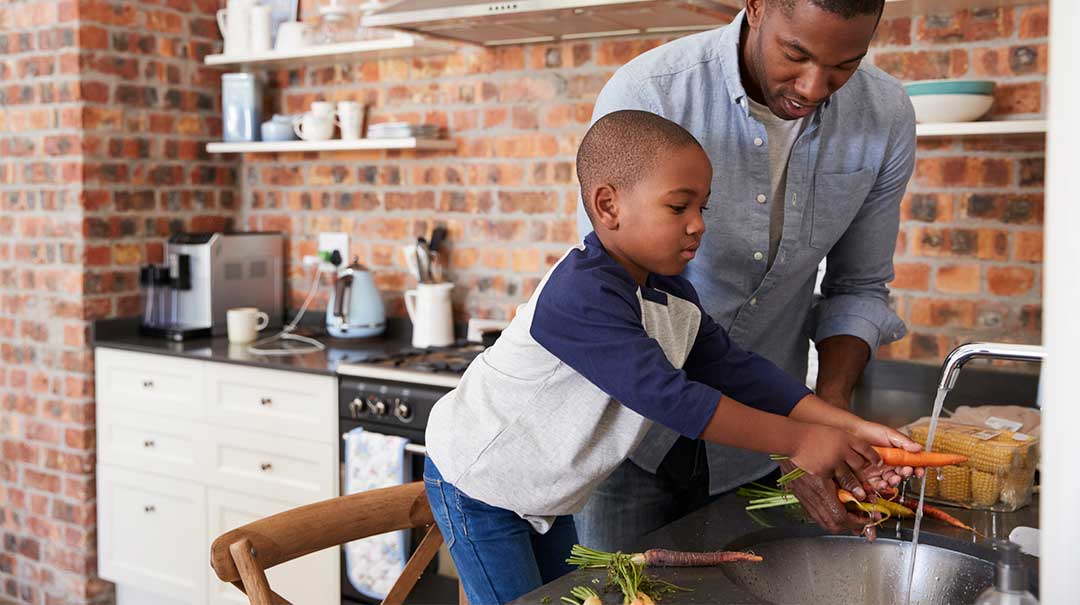The Centers for Disease Control (CDC) estimates that about 48 million people—roughly 1 in 6 Americans—get sick each year from food borne illness, such as food poisoning, caused by unseen, harmful bacteria. Of those, 128,000 are hospitalized and 3,000 die from food borne disease.
In cross-contamination, harmful bacteria are inadvertently transferred from foods, surfaces, utensils or hands to other foods. Hand-washing is a crucial step many of us forget when we’re cooking at home. We can prevent most cases of contamination and foodborne illness at home if we practice four effective steps for proper cleanliness and food preparation.
The 4 Cs: 4 Tips to Avoid Cross-contamination
1. Clean
Wash your hands often with soap and water for at least 20 seconds each time to prevent the spread of bacteria—before, during and after cooking. Make sure to also wash everything your food touches when cooking:
- Appliances
- Countertops and surfaces
- Cutting boards
- Utensils
Fruits and vegetables also need to be cleaned well. Imagine all the people in the grocery store who may have sorted through a pile of apples, looking for just the right one! In the process, they’re also spreading germs. Fruits and vegetables also may contain small amounts of chemicals or pesticide residues used in the farming process as well as dirt from the ground. Give fruits a good rinse in cold water before that first bite to eliminate germs they may have picked up before making their way to you. You don’t need a special fruit wash—water is good enough.
When preparing meals or snacks with raw vegetables, make sure you rinse them so they don’t spread bacteria to your hands, knives or any other food items. Keep surfaces clean as you go along.
Sometimes not washing is just as important as washing—specifically when it comes to poultry. I don’t recommend rinsing chicken or turkey at all. Instead of eliminating bacteria, washing or rinsing causes it to spread. Instead, take the meat out of its packaging, trim it if needed, and proceed with cooking. Any bacteria on the skin of the bird will be destroyed as long as the meat is cooked thoroughly.
2. Compartmentalize
Keep foods separate in your shopping cart and in your grocery bags. When you store things in the refrigerator, seal well any raw foods that need to be cooked and place it in the lower part of the fridge so it won’t ruin other foods if it drips or leaks. Keep eggs in their original carton for that same reason. Separating foods is especially vital for people with allergies. A very small amount of an allergen, such as nuts, could cause an allergic reaction.
If you’re the kind of cook who washes utensils while preparing food, keep the items you’ve hand-washed well away from your sink. That way, if you’re adding dirty dishes to the sink or rinsing utensils, they won’t splash up on the items that you’ve already cleaned.
As often as possible, use separate cutting boards, utensils and knives for raw poultry or eggs, raw meat or seafood and produce. Multicolored cutting boards and utensil handles can help keep equipment separate. You can also cut up your vegetables first, then your meats to avoid cross-contamination and save cleaning time.
3. Chill
As soon as you get home from the store, put away items that require freezing or refrigeration. Check every now and then to make sure your refrigerator and freezer are set at the right temperatures:
- Set the refrigerator temperature at 40 degrees or colder.
- Keep the freezer at 0 degrees to avoid bacteria growth.
- Make sure items in the fridge or freezer aren’t crowded so the cold air can circulate.
- Use inexpensive appliance thermometers to monitor the refrigerator and the freezer.
4. Cook
While cooking, make sure food reaches the correct internal temperature, such as 165 degrees for chicken or turkey and 145 degrees for steak. These temperatures will destroy any potentially harmful bacteria. Never assume meat is done cooking because it "looks OK." I highly recommend using a food thermometer to ensure the proper temperature has been reached, as color and texture are not reliable indicators of doneness.
Microwaves are handy for cooking and heating foods, and we should follow safe food practices when using them, too. Microwave directions often state that the food should sit for a few minutes after the cooking time. This is because the temperature will continue to rise, allowing for a more even heat distribution. After waiting a few minutes, check the temperature with a food thermometer to make sure it’s 165 degrees or above for chicken and beef.
Food poisoning can be very dangerous, especially for vulnerable populations, such as pregnant women, young children and the elderly. By following these basic steps for food safety, we can avoid food poisoning and help keep our families safe.
In need of urgent care for a food borne illness?
Click the button below to check-in online to a MedStar Health Urgent Care near you.
Learn More

